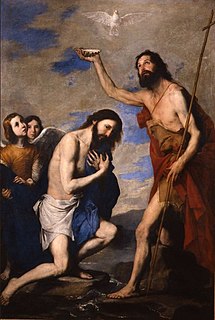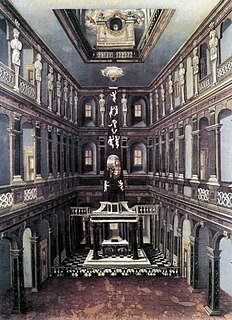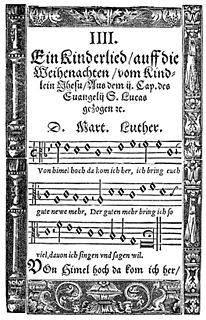
"Our Father, Thou in Heaven Above" is a Lutheran Christian hymn based on The Lord's Prayer originally written in German in 1539 by Martin Luther and translated in 1863 into English by Catherine Winkworth. [1]

"Our Father, Thou in Heaven Above" is a Lutheran Christian hymn based on The Lord's Prayer originally written in German in 1539 by Martin Luther and translated in 1863 into English by Catherine Winkworth. [1]
Martin Luther wrote "Vater unser im Himmelreich" based on The Lord's Prayer. Each verse of the hymn is used to elaborate on the requests in the Lord's Prayer to God. [2] It was first published in 1539 in the Geistliche Lieder hymn book by Valentin Schumann and set to the tune of "Vater Unser" by an unknown composer. [1]
In 1863, Luther's hymn was translated by the English Church of England hymn-translator Catherine Winkworth, who gave it the title of "Our Father, Thou in Heaven Above". [3] It was first published in Winkworth's The Chorale Book for England. [4] Her translation used the original textual style of Luther, with a theme of justice at a time when that theme was not as prevalent in hymns. [4]
The scriptural inspiration for "Our Father, Thou in Heaven Above" was Matthew 6:9–12, the source of The Lord's Prayer. [3]

"A Mighty Fortress Is Our God" is one of the best known hymns by the reformer Martin Luther, a prolific hymnodist. Luther wrote the words and composed the melody sometime between 1527 and 1529. It has been translated into English at least seventy times and also into many other languages. The words are a paraphrase of Psalm 46.

"Gloria in excelsis Deo" is a Christian hymn known also as the Greater Doxology and the Angelic Hymn/Hymn of the Angels. The name is often abbreviated to Gloria in Excelsis or simply Gloria.

Catherine Winkworth was an English hymnwriter and educator. She translated the German chorale tradition of church hymns for English speakers, for which she is recognized liturgically by The Episcopal Church and the Evangelical Lutheran Church in America. She also worked for wider educational opportunities for girls, and translated biographies of two founders of religious sisterhoods. When 16, Winkworth appears to have coined a once well-known political pun, peccavi, "I have Sindh", relating to the British occupation of Sindh.

Johann Sebastian Bach composed the church cantata Christ unser Herr zum Jordan kam, BWV 7, in Leipzig for the Feast of St. John the Baptist and led its first performance on 24 June 1724.

The Orgelbüchlein BWV 599−644 is a set of 46 chorale preludes for organ — one of them is given in two versions — by Johann Sebastian Bach. All but three were written between 1708 and 1717 when Bach served as organist to the ducal court in Weimar; the remainder and a short two-bar fragment came no earlier than 1726, after the composer’s appointment as cantor at the Thomasschule in Leipzig.

Psalm 46 is the 46th psalm of the Book of Psalms, known in English by its beginning, "God is our refuge and strength, a very present help in trouble" in the King James Version. In the Greek Septuagint version of the Bible, and in its Latin translation in the Vulgate, this psalm is Psalm 45 in a slightly different numbering system. In Latin, it is known as "Deus noster refugium et virtus". The song is attributed to the sons of Korah.
Media vita in morte sumus is the first line of a Gregorian chant, written in the form of a response, and known as "Antiphona pro Peccatis" or "de Morte". The most accepted source is a New Year's Eve religious service in the 1300s. Reference has been made to a source originating in a battle song of the year 912 by Notker the Stammerer, a monk of the Abbey of Saint Gall, however, the Synod of Cologne declared in 1316 that no one should sing this without the prior permission of the residing bishop.

"Was willst du dich betrüben" is a hymn in seven stanzas by the German Baroque poet, Lutheran minister and hymn-writer Johann Heermann. The chorale was first published in 1630 during the Thirty Years' War. It is focused on trust in God, even when facing adversaries.

"Komm, Heiliger Geist, Herre Gott" is a Lutheran hymn for Pentecost, with words written by Martin Luther based on "Veni Sancte Spiritus, reple tuorum corda fidelium". The hymn in three stanzas was first published in 1524. For centuries the chorale has been the prominent hymn (Hauptlied) for Pentecost in German-speaking Lutheranism. Johann Sebastian Bach used it in several chorale preludes, cantatas and his motet Der Geist hilft unser Schwachheit auf, BWV 226.
"Vater unser im Himmelreich" is a Lutheran hymn in German by Martin Luther. He wrote the paraphrase of the Lord's Prayer in 1538, corresponding to his explanation of the prayer in his Kleiner Katechismus. He dedicated one stanza to each of the seven petitions and framed it with an opening and a closing stanza, each stanza in six lines. Luther revised the text several times, as extant manuscript show, concerned to clarify and improve it. He chose and possibly adapted an older anonymous melody, which was possibly associated with secular text, after he had first selected a different one. Other hymn versions of the Lord's Prayer from the 16th and 20th-century have adopted the same tune, known as "Vater unser" and "Old 112th".

"Christ ist erstanden" is a German Easter hymn, and is possibly the oldest Christian liturgical German song. It has inspired music by composers such as Ludwig Senfl and Heinrich Schütz through to modern composers such as Oskar Gottlieb Blarr and Enjott Schneider, and has appeared in 45 hymnals, including the current German Catholic and Protestant hymnals. Translations and paraphrases include a version by Catherine Winkworth which has appeared in 231 hymnals. "Christ ist erstanden" also inspired Martin Luther to write "Christ lag in Todes Banden", deriving the melody from it.

"Vom Himmel hoch, da komm ich her" is a hymn text relating to the Nativity of Jesus, written by Martin Luther in 1534. The hymn is most often sung to a melody, Zahn No. 346, that first appeared in 1539 and that was likely composed by Luther as well. That version became a classic Christmas carol, and many composers referred to it in their compositions.
Edward Wilton Eddis was a poet and prophet in the Catholic Apostolic Church at Westminster, London and co-author of the Hymns for the Use of the Churches, the hymnal of the Catholic Apostolic Church.
Jane Laurie Borthwick was hymn writer, translator of German hymns and a noble supporter of home and foreign missions. She published under the pseudonym: H. L. L.. Jane Laurie Borthwick is best known for the Hymns from the Land of Luther; her most famous translation today is Be still, my soul and her most known original text is Come, labor on. Like Catherine Winkworth and Frances Cox Henderson, she greatly contributed to English-language hymnody by mediating German hymnody.
"Jesus Christus, unser Heiland, der von uns den Gotteszorn wandt" is a Lutheran hymn in ten stanzas by Martin Luther for communion, first published in 1524 in the Erfurt Enchiridion. It is one of Luther's hymns which he wrote to strengthen his concepts of reformation. The models for the text and the melody of Luther's hymn existed in early 15th-century Bohemia. The text of the earlier hymn, "Jesus Christus nostra salus", goes back to the late 14th century. That hymn was embedded in a Hussite tradition.
"Christ the Lord Is Risen Again!" is a German Christian hymn written by Michael Weiße in 1531 based on an earlier Bohemian hymn of the same name. It was translated into English in 1858 by Catherine Winkworth.
"Herr Jesu Christ, wahr Mensch und Gott" is a Lutheran hymn by Paul Eber. It is a hymn for the dying. One of the hymn's tunes, Zahn No. 423, is also used for "Wir danken dir, Herr Jesu Christ".

"In dich hab ich gehoffet, Herr" is a Lutheran hymn in seven stanzas, written by Adam Reusner and first published in 1533. He paraphrased the beginning of Psalm 31. It was first sung to the melody of a Passion hymn. The melody connected with the hymn in 1560 was derived from models dating back to the 14th century. A third melody from 1608 became a hymn tune for several other songs and translations to English. In the German Protestant hymnal Evangelisches Gesangbuch, the hymn appears as EG 257 with the second melody. Johann Sebastian Bach used the second and third melodies in chorale preludes, and the third also in cantatas and the St Matthew Passion.
Church music during the Reformation developed during the Protestant Reformation in two schools of thought, the regulative and normative principles of worship, based on reformers John Calvin and Martin Luther. They derived their concepts in response to the Catholic church music, which they found distracting and too ornate. Both principles also pursued use of the native tongue, either alongside or in place of liturgical Latin.